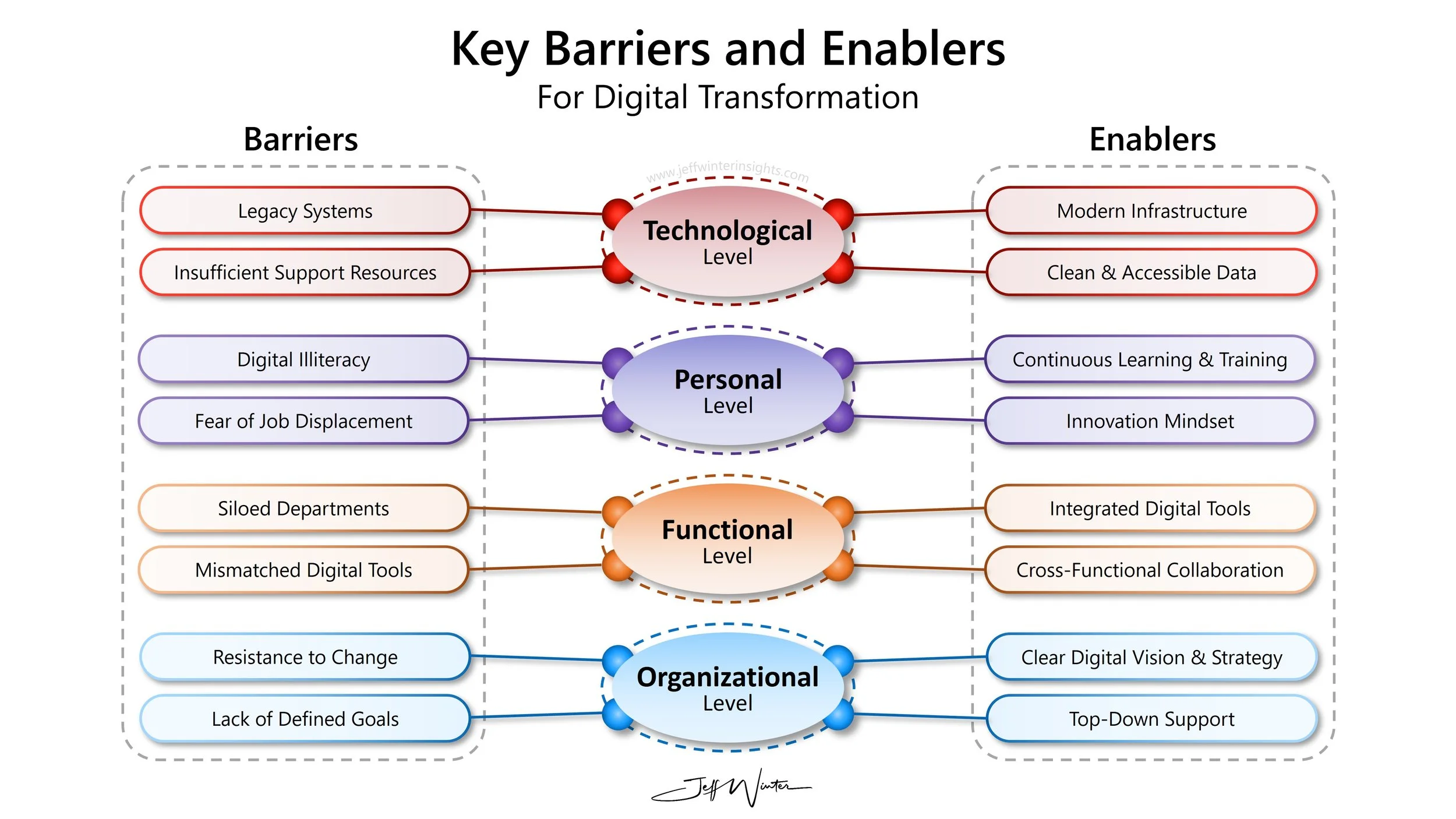Key Barriers and Enablers of Digital Transformation
Pivoting with Purpose: The Real Work of Digital Transformation
Let’s clear something up: Digital transformation isn’t about adopting technology. It’s about adapting your business.
We’ve glamorized the term for so long that it’s lost its meaning. AI, digital twins, MES, data lakes, robotics, predictive this, generative that. They all sound exciting. But without a strong foundation—without purpose, alignment, and strategy—they're just expensive distractions.
Here’s the truth that doesn’t get said enough:
You can buy all the cutting-edge tech in the world and still be stuck in an Industry 3.0 mindset.
Why? Because transformation happens at every layer of your organization—not just in your servers and sensors, but in your structure, your teams, your workflows, and your culture.
In reality, most companies don’t fail at digital. They fail at transformation. They underestimate the friction, overestimate their readiness, and don’t spend enough time getting the basics right. And so, what should be a leap forward turns into a pile of disconnected pilot projects, a frustrated workforce, and a leadership team wondering where all that budget went.
So what separates the companies who make it from the ones who stall?
It's not just better tools. It's a better understanding of the barriers that silently hold you back and the enablers that quietly accelerate your momentum. It’s knowing how to design a transformation that works across all four layers of your business—organizational, functional, personal, and technological—and not just dumping everything on IT or expecting a shiny platform to magically align your operations.
Think of digital transformation as a game of tug-of-war.
On one side: outdated systems, resistance to change, siloed departments, and leadership that’s more reactive than strategic.
On the other: modern infrastructure, empowered employees, aligned cross-functional teams, and a bold, clearly defined vision.
If you don’t recognize the forces pulling in both directions—and learn how to shift the balance—you’ll be stuck. Your strategy won’t gain traction. Your teams won’t know where to go. And your transformation? It’ll be little more than a buzzword on a slide deck.
This guide is designed to help you avoid that fate.
We’re breaking down the key enablers and barriers to digital transformation—level by level—to help you diagnose where you’re strong, where you’re exposed, and where your strategy needs a rethink. Because the companies that will define the next decade aren’t the ones with the flashiest tools.
They’re the ones who can pivot with purpose.
Enablers for Digital Transformation
Organizational Level:
Clear Digital Vision & Strategy: Establishing a comprehensive and forward-thinking digital plan for the entire organization.
Top-Down Support: Ensuring the senior leadership is involved, invested, and champions the digital initiatives.
Functional Level:
Integrated Digital Tools: Implementing and harmonizing digital solutions across functions to increase efficiency and collaboration.
Cross-Functional Collaboration: Facilitating departments to work together on digital projects and share knowledge.
Personal Level:
Continuous Learning & Training: Empowering employees with regular upskilling opportunities in the digital realm.
Innovation Mindset: Encouraging individuals to think creatively and be open to new digital possibilities.
Technological Level:
Modern Infrastructure: Investing in up-to-date technology foundations to support all digital activities.
Clean and Accessible Data: Ensuring the organization's digital assets are well-protected against potential threats.
Barriers for Digital Transformation
Organizational Level:
Resistance to Change: Difficulty in shifting from traditional practices to new digital methodologies.
Lack of Defined Goals: Not having a clear understanding of the desired outcomes from the digital transformation.
Functional Level:
Siloed Departments: Functions operating in isolation, leading to disjointed digital efforts.
Mismatched Digital Tools: Different functions using incompatible digital tools, hindering interoperability.
Personal Level:
Digital Illiteracy: Employees not familiar with the new tools or digital concepts.
Fear of Job Displacement: Concerns about digital tools taking over human roles.
Technological Level:
Legacy Systems: Outdated technology platforms that are incompatible with modern solutions.
Insufficient Tech Support: Not having the right technical support to maintain and troubleshoot digital platforms.
This conceptual breakdown provides an overview of potential barriers and enablers for digital transformation across different levels of an organization. The specific barriers and enablers might vary for different organizations based on their unique contexts.
Tips for Using Enablers to Overcome Barriers
Build a Digital Ecosystem: Create an environment where your vision, tools, collaboration, and infrastructure not only coexist but also work together harmoniously. Think of it like a well-oiled machine, where every part enhances the other.
Embrace an Adaptive Culture: Get everyone on board with a mindset where change isn’t just accepted, but anticipated and embraced. Make it part of your company’s DNA. When change is the norm, innovation flows naturally.
Invest in Your People: Your team is your biggest asset. Don’t just train them—motivate them to innovate. Make sure they grow alongside technological advancements, keeping the human touch at the forefront of your digital journey.
Focus on Agile Infrastructure: Keep your tech investments flexible. This way, you can quickly pivot and integrate new opportunities and tackle challenges head-on. Agility is key to staying ahead in a changing market.
By focusing on creating a holistic digital ecosystem where each aspect supports the others, you build a strong foundation for transformation. The goal is to create a self-sustaining cycle of innovation and improvement that drives your organization forward with clarity and confidence.

